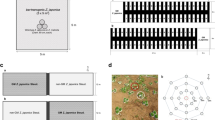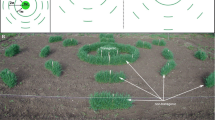Abstract
The testing of transgenic crops in the field is a necessary part of the validation of genetically engineered cultivars, but in the early stages of testing, biosafety procedures must be carefully monitored to ensure that the modified plants do not have deleterious effects on the environment. This study was carried out over two seasons to determine the effectiveness of containment procedures under australian environmental conditions by measuring the dispersal of pollen amay from a test plot of transgenic cotton into a surrounding buffer field of non-transgenic cotton plants whose function was to act as a sink for pollen carried by nectar feeding and pollen-gathering insects. Dispersal was estimated by measuring the frequency of the dominant selectable marker transgene, neomycin phosphotransferase (NptII) in the progeny of the buffer plants. The presence of nptii was determined by a sensitive radioactive enzyme assay. Pollen dispersal was low in both years, but increased with an increase in the size of the source plot in the second year. In the first year outcrossing averaged from 0.15% of progeny at 1 m to below 0.08% at 4 m from the test plot. Outcrossing was highest within the central test plot where progeny from non-transgenic control plants, immediately adjacent to transgenic plants, had transgenic progeny at frequencies of up to 1.7%. In the second year, with a bigger source of transgenic plants, outcrossing declined on average from 0.4% at 1 m to below 0.03% at 16 m into the buffer zone. These results indicate that 20 m buffer zones would serve to limit dispersal of transgenic pollen from small-scale field tests.
Similar content being viewed by others
References
Brown MS, Menzel MY: Polygenomic hybrids in Gossypium. I. Cytology of hexaploids, pentaploids and hexaploid combinations. Genetics 37: 242–263 (1952).
Dale PJ: Spread of engineered genes to wild relatives. Plant Physiol 100: 13–15 (1992).
Fitt GP, Mares CL, Llewellyn DJ: Field evaluation and potential ecological impact of transgenic cottons (Gossypium hirsutum) in Australia. Biocontrol Sci Technol 4: 535–548 (1994).
Free JB: Insect Pollination of Crops, 2nd ed., pp. 352–371. Academic Press, London (1993).
Fryxell PA, Craven LA, McD Stuart J: A revision of Gossypium sect. Grandicalyx (Malvaceae), including the description of six new species. Syst Bot 17: 91–114 (1992).
Kareiva P, Manasse R, Morris W: Using models to integrate data from field trials and estimate risks of gene escape and gene spread. In: McKenzie DR, Henry SC (eds) Biological Monitoring of Genetically Engineered Plants and Microbes, pp. 31–42. Agricultural Research Institute, Bethesda, MA (1990).
McDonnell RE, Clark RD, Smith WA, Hinchee MA: A simplified method for the detection of neomycin phosphotransferase II activity in transformed plant tissues. Plant Mol Biol Rep 5: 380–386 (1987).
Mungomery VE, Glassop AJ: Natural cross-pollination of cotton in central Queensland. Queensland J Agric Sci 26: 69–74 (1969).
Organisation for Economic Co-operation and Development: Field releases of transgenic plants, 1986–1992: an analysis, 37 pp. OECD, Paris (1993).
Perlak FJ, Deaton RW, Armstrong TA, Fuchs TA, Sims SR, Greenplate JT, Fischoff DA: Insect resistant cotton plants. Bio/technology 8: 939–943 (1990).
Rogers HJ, Parkes HC: Transgenic plants and the environment. J Exp Bot 46: 467–488 (1995).
Rooney WL, Stelly DM, Altman DW: Identification of four Gossypium sturtianum monosomic addition derivatives from a backcrossing program with G. hirsutum. Crop Sci 31: 337–341 (1991).
Teijde JK, Colwell K, Grossman YL: The planned introduction of genetically engineered organisms: ecological consequences and recommendations. Ecology 70: 298–315 (1989).
Thies SA: Agents concerned with natural crossing of cotton in Oklahoma. Agron J 45: 481–484 (1953).
Thomson NJ: Cotton variety trials in the Ord Valley, North Western Australia. 4. Natural crossing of cotton. Empire Cotton Grow Rev 43: 18–21 (1966).
Umbeck PF, Barton KA, Nordheim EV, McCarty JC, Parrott WL, Jenkins JN: Degree of pollen dispersal by insects from a field test of genetically engineered cotton. J Econ Entomol 84: 1943–1950 (1991).
Author information
Authors and Affiliations
Rights and permissions
About this article
Cite this article
Llewellyn, D., Fitt, G. Pollen dispersal from two field trials of transgenic cotton in the Namoi Valley, Australia. Mol Breeding 2, 157–166 (1996). https://doi.org/10.1007/BF00441430
Received:
Accepted:
Issue Date:
DOI: https://doi.org/10.1007/BF00441430




